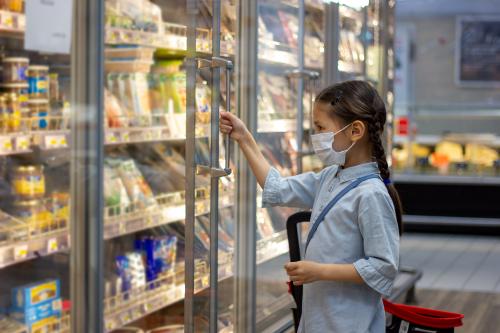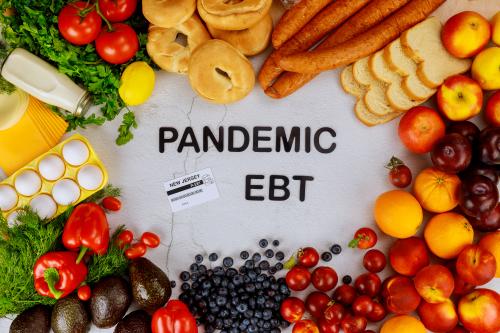Too many families in the U.S. struggle to put food on the table. During the pandemic, both tried-and-true policy levers and brand-new programs and flexibilities were put in place to help families. In the aggregate, the combination of additional resources and lower administrative barriers was effective: on an annual basis, the national level of food insecurity held steady from 2019 to 2020.
The Pandemic EBT program (“Pandemic EBT” or PEBT) has proven to be a vital policy tool in these efforts. Pandemic EBT is a social insurance program that functions similarly to SNAP: families receive benefits on an EBT debit card which is then used to purchase food at most grocery stores. The dollar amount that families receive is equal to the value of free school breakfasts and lunches students missed due to pandemic-related school closures.
When schools close for the summer—even in the years before the pandemic—food hardship among families with children rises. But there is a policy that can help: for the summer of 2022, summer months count as school closures and all states can apply to provide eligible children with Pandemic EBT.
This analysis finds that in the month leading into this summer (i.e., in May 2022), food insufficiency was lower in states that distributed substantial Pandemic EBT benefits to compensate for meals lost during pandemic-related school closures. We find that a third of states have not yet been approved for Pandemic EBT to cover the summer of 2022. Even among the states that are approved, we have struggled to document the extent to which any resources were distributed to households during these months, much less whether these resources were on-time summer payments or delayed school year payments. Relatedly, food insufficiency among households with children, and especially among lower-income households with children, rose at the end of the 2021-22 school year and has remained elevated.
Pandemic EBT has proven to be an effective program for helping families when schools closed because of the pandemic. Going forward, a permanent program like Pandemic EBT has the potential to be a powerful tool to fight food hardship among children when schools close for summer. But to realize its potential, states need to participate in the program and deliver benefits in a timely manner.
Rates of food insufficiency change with federal policy
The Census Bureau’s Household Pulse Survey (“Pulse”) has been collecting real-time data on material hardship since the spring of 2020. Though the survey instrument has changed over time (meaning, for example, that the order of questions has changed), respondents have been asked to assess the state of food availability in their households throughout the survey. The Pulse measure of food insufficiency—households reporting sometimes or often not having enough to eat in the last week—has captured food hardship in real time during the pandemic.
Figure 1 shows household rates of food insufficiency from September 2020 through early August 2022 as well as indicators for the timing of select policies. Reported food insufficiency is plotted for households with (dark blue) and without school-aged children (dark green) overall as well as for households with (light blue) and without (light green) children who reported an annual income of less than $50,000. Lower-income families with children have higher rates of food insufficiency throughout the period, and also exhibit more volatility, suggesting the potential for policy responses to affect food hardship.
Numerous national policy changes since 2020 have had the potential to affect food insufficiency. These policies, denoted by vertical lines in Figure 1, include increases to SNAP benefits via a 15 percent maximum benefit increase, which was effective from January to September 2021, and the implementation of the October 2021 Thrifty Food Plan reform. Other policies not directly tied to nutritional assistance, such as Economic Impact Payments and expanded Child Tax Credit disbursements that reached more lower-income families on a monthly basis, could also affect food hardship by increasing families’ resources.

Figure 1 shows that policies that expanded household resources coincided with a reduction in food insufficiency, especially among lower-income families with children. The first two drops in food insufficiency coincided with the 15 percent SNAP maximum benefit increase and the last two rounds of Economic Impact Payments (EIPs) in January and March of 2021. At these times, households without children exhibited a less notable decrease. Between the first and last monthly Child Tax Credit (CTC) payments, food insufficiency among households with children was consistently lower, while among households without children, food insufficiency remained steady. Food insufficiency has been rising throughout 2022, with the most dramatic increase visible since the end of many states’ school years among households with children making less than $50,000 in a year.
This figure shows that both increasing the value of SNAP benefits and providing direct relief to households put downward pressure on rates of food insufficiency. Since the expiration of the monthly CTC benefits, the end of the school year, and inflation-driven pressures on household finances, rates of food insufficiency have been on the rise again. As of August 8, 2022, about 15 percent of households with school-aged children experienced food insufficiency and the rate was about 28 percent among such households with annual income less than $50,000.
Food insufficiency varied across states by Pandemic EBT disbursements
Because school meal programs are integral to addressing child food insecurity in the United States, many entities, including Congress, the USDA, states, and schools, took action in response to pandemic-related school closures to reconstitute the food safety net for children. We have evaluated the impact of one of these key measures: Pandemic EBT.
Our previous work showed that Pandemic EBT reduced food hardship. The first week after Pandemic EBT benefits were paid in the spring and summer of 2020, the share of children not getting enough to eat declined by about 8 percentage points (30 percent). During the 2020-21 school year , we found that Pandemic EBT reduced very low food security among children in SNAP households by 17 percent, and reduced food insufficiency in these households by 28 percent. In states with relatively high rates of school closures due to COVID-19, Pandemic EBT provided larger relief, reducing child very low food security by 22 percent and household food insufficiency by 39 percent.
Our prior work documented a causal relationship between Pandemic EBT and reduction in food hardship during Summer 2020 and the 2020-21 school year. These evaluations also establish that the Pulse measures of food hardship are sensitive to economic and policy changes at both the national and state levels. Indeed, as Figure 1 shows, there were often sharp drops in reported food hardship coincident with the expansion of resources that could be used to purchase food.
Pandemic EBT is another such resource but is not indicated in Figure 1 since payment timing differs across states. As our previous work showed, payments can be delayed several months after the school closure, and this delay varies across states and over time. Crucially in the 2021-22 school year, as in-person instruction became more common, Pandemic EBT amounts dropped because more children had access to in-person school meals.
In this analysis, we focus on the relationship between food insufficiency and Pandemic EBT payments from late April to early May 2022. Pandemic EBT dollars paid in May are part of the 2021-22 school year funding cycle, so the states that released disbursements did so to cover closures during that school year; some states paid out substantial amounts as they caught up on making delayed payments. In late April and early May most schools are still in session, so Pandemic EBT disbursements were layered on top of current receipt of regular school meals in many places. Moreover, state-level disbursement data on summer Pandemic EBT disbursements is not yet available from USDA and we were not able to independently verify in what states payments were being disbursed during the summer months.
At the end of the 2021-22 school year, the association between Pandemic EBT disbursements and reduced food insufficiency persisted, even as there were fewer school closures and therefore lower Pandemic EBT disbursements. Figure 2 shows food insufficiency in late April and early May 2022 for households by three groups of states: those that did not distribute any Pandemic EBT in May (“No PEBT”), those that distributed less than the proportional amount of benefits in May (“Low PEBT”), and those that distributed more than the proportional amount of benefits in May (“High PEBT”). We use 13 percent of a state’s total 2021-22 school year Pandemic EBT resources as the threshold to represent one month of missed school meals. [1]

Figure 2 indicates that states that distributed a substantial amount of Pandemic EBT in May had lower rates of food insufficiency among lower-income households with children, i.e., those who were most likely to have received substantial Pandemic EBT benefits in May compared with those living in states that disbursed no or lower amounts. Rates of food insufficiency are not statistically different across these groups of states for households without children, who are not eligible for Pandemic EBT. Differences in food insufficiency across the three groups of states are also less pronounced among households of all income levels with children, indicating that targeted benefits provide the largest benefit for those with the greatest need.
A place for Pandemic EBT in preventing food hardship
Pandemic EBT was originally authorized in March 2020 and has been reauthorized and reformed three times: in October 2020, December 2020, and through the American Rescue Plan in March 2021. The American Rescue Plan Act authorized Pandemic EBT in any future school year and subsequent summer in which a public health emergency is in effect, providing benefits that are complementary to the Summer Food Service Program. While 2021-22 benefits were variable and tied to school closures, for the summer of 2022, every state could apply for Pandemic EBT and every eligible child could receive the value of full benefits for the summer months or about $6 per child per day.
Figure 3 shows which states have been approved to operate Pandemic EBT during the summer of 2022. As of mid-August 2022, 16 states have not been approved to provide Pandemic EBT for summer 2022. Five of these states (Alaska, Idaho, Iowa, New Hampshire, and South Dakota) did not apply for Pandemic EBT for the 2021-22 school year or for Summer 2022.

It is not too late for these states to apply or be approved for Pandemic EBT for the 2022 summer period and to make disbursements into the fall. Indeed, many states that have already submitted their applications intend to provide disbursements later in 2022.
But such delays should be avoided in the future, especially given the evidence presented above that 1) there was an immediate and large increase in food insufficiency among low-income households with children at the start of the summer and 2) timely and targeted resources reduce measures of food hardship. The incomplete implementation of Pandemic EBT during the summer of 2022 across states is disappointing—especially given rising inflation and waning fiscal aid to households.
Conclusion
Federal child nutrition policy over the past year, in conjunction with the Summer EBT proposal before Congress, comports with what we argued for in the lead-up to the initial authorization for Pandemic EBT: when schools are closed, EBT benefits could be a mechanism to provide resources to purchase food at time of predictable (summer) and unpredictable (emergency) need. By working through the many challenges in implementing Pandemic EBT, and with clearer eligibility criteria and disbursements mechanisms, Summer EBT could roll out in a timely and consistent basis across the U.S. in the future.
Food insecurity, especially when experienced by children, is an unnecessarily persistent problem in the United States.
Food insecurity, especially when experienced by children, is an unnecessarily persistent problem in the United States. In its first two periods of operation (the summer of 2020 and the 2020-21 school year), we found the Pandemic EBT program caused significant reductions in food hardship among families. On the strength of this evidence and experimental evidence of the causal effect of Summer EBT on food hardship, policymakers have made moves to make the primary feature of Pandemic EBT—providing grocery money to families when schools are closed—permanent.
The accumulating evidence is strong that providing financial resources to families to purchase food that meets their family’s dietary needs and preferences alleviates food hardship. These policies should be core to solutions considered at the White House Conference on Hunger, Nutrition, and Health and by Congress as it takes up the Child Nutrition and Farm Bill reauthorizations.
This technical appendix accompanies “Food security shouldn’t take a summer vacation.”
[1] Although distributions could be proportionally high because of a relatively large number of school closures in May, the more likely reason would be that states with high distributions were catching up on delayed payments. The 13 percent value is based on an assumption of an even distribution of total expended resources and is meant to distinguish states in which a measurable effect could reasonably be detected from states where it could not. For example, Michigan distributed 72 percent of its school year 2021-22 Pandemic EBT money in May while Missouri distributed 5 percent.
The Brookings Institution is financed through the support of a diverse array of foundations, corporations, governments, individuals, as well as an endowment. A list of donors can be found in our annual reports, published online. The findings, interpretations, and conclusions in this report are solely those of its author(s) and are not influenced by any donation.
The Brookings Institution is committed to quality, independence, and impact.
We are supported by a diverse array of funders. In line with our values and policies, each Brookings publication represents the sole views of its author(s).










Commentary
Food security shouldn’t take a summer vacation
August 26, 2022